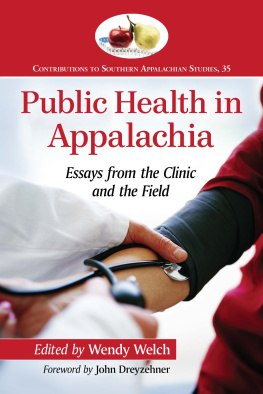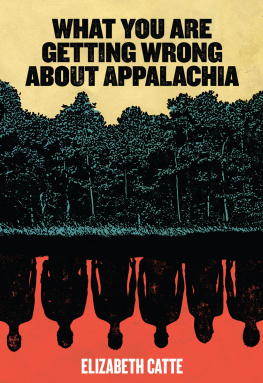
CONTRIBUTIONS TO SOUTHERN APPALACHIAN STUDIES
1. Memoirs of Grassy Creek: Growing Up in the Mountains on the VirginiaNorth Carolina Line. Zetta Barker Hamby. 1998
2. The Pond Mountain Chronicle: Self-Portrait of a Southern Appalachian Community. Edited by Leland R. Cooper and Mary Lee Cooper. 1998
3. Traditional Musicians of the Central Blue Ridge: Old Time, Early Country, Folk and Bluegrass Label Recording Artists, with Discographies. Marty McGee. 2000
4. W.R. Trivett, Appalachian Pictureman: Photographs of a Bygone Time. Ralph E. Lentz II. 2001
5. The People of the New River: Oral Histories from the Ashe, Alleghany and Watauga Counties of North Carolina. Edited by Leland R. Cooper and Mary Lee Cooper. 2001
6. John Fox, Jr., Appalachian Author. Bill York. 2003
7. The Thistle and the Brier: Historical Links and Cultural Parallels Between Scotland and Appalachia. Richard Blaustein. 2003
8. Tales from Sacred Wind: Coming of Age in Appalachia. The Cratis Williams Chronicles. Cratis D. Williams. Edited by David Cratis Williams and Patricia D. Beaver. 2003
9. Willard Gayheart, Appalachian Artist. Willard Gayheart and Donia S. Eley. 2003
10. The Forest City Lynching of 1900: Populism, Racism, and White Supremacy in Rutherford County, North Carolina. J. Timothy Cole. 2003
11. The Brevard Rosenwald School: Black Education and Community Building in a Southern Appalachian Town, 19201966. Betty J. Reed. 2004
12. The Bristol Sessions: Writings About the Big Bang of Country Music. Edited by Charles K. Wolfe and Ted Olson. 2005
13. Community and Change in the North Carolina Mountains: Oral Histories and Profiles of People from Western Watauga County. Compiled by Nannie Greene and Catherine Stokes Sheppard. 2006
14. Ashe County: A History; A New Edition. Arthur Lloyd Fletcher. 2009 [2006]
15. The New River Controversy; A New Edition. Thomas J. Schoenbaum. Epilogue by R. Seth Woodard. 2007
16. The Blue Ridge Parkway by Foot: A Park Rangers Memoir. Tim Pegram. 2007
17. James Still: Critical Essays on the Dean of Appalachian Literature. Edited by Ted Olson and Kathy H. Olson. 2008
18. Owsley County, Kentucky, and the Perpetuation of Poverty. John R. Burch, Jr. 2008
19. Asheville: A History. Nan K. Chase. 2007
20. Southern Appalachian Poetry: An Anthology of Works by 37 Poets. Edited by Marita Garin. 2008
21. Ball, Bat and Bitumen: A History of Coalfield Baseball in the Appalachian South. L.M. Sutter. 2009
22. The Frontier Nursing Service: Americas First Rural Nurse-Midwife Service and School. Marie Bartlett. 2009
23. James Still in Interviews, Oral Histories and Memoirs. Edited by Ted Olson. 2009
24. The Millstone Quarries of Powell County, Kentucky. Charles D. Hockensmith. 2009
25. The Bibliography of Appalachia: More Than 4,700 Books, Articles, Monographs and Dissertations, Topically Arranged and Indexed. Compiled by John R. Burch, Jr. 2009
26. Appalachian Childrens Literature: An Annotated Bibliography. Compiled by Roberta Teague Herrin and Sheila Quinn Oliver. 2010
27. Southern Appalachian Storytellers: Interviews with Sixteen Keepers of the Oral Tradition. Edited by Saundra Gerrell Kelley. 2010
28. Southern West Virginia and the Struggle for Modernity. Christopher Dorsey. 2011
29. George Scarbrough, Appalachian Poet: A Biographical and Literary Study with Unpublished Writings. Randy Mackin. 2011
30. The Water-Powered Mills of Floyd County, Virginia: Illustrated Histories, 17702010. Franklin F. Webb and Ricky L. Cox. 2012
31. School Segregation in Western North Carolina: A History, 1860s1970s. Betty Jamerson Reed. 2011
32. The Ravenscroft School in Asheville: A History of the Institution and Its People and Buildings. Dale Wayne Slusser. 2014
33. The Ore Knob Mine Murders: The Crimes, the Investigation and the Trials. Rose M. Haynes. 2013
34. New Art of Willard Gayheart. Willard Gayheart and Donia S. Eley. 2014
35. Public Health in Appalachia: Essays from the Clinic and the Field. Edited by Wendy Welch. 2014
36. The Rhetoric of Appalachian Identity. Todd Snyder. 2014
Public Health in Appalachia
Essays from the Clinic and the Field
Edited by WENDY WELCH
Foreword by John Dreyzehner
CONTRIBUTIONS TO SOUTHERN APPALACHIAN STUDIES, 35

McFarland & Company, Inc., Publishers
Jefferson, North Carolina
When OxyContin Struck, and How the Community Struck Back: One Woman Remembers by Sue Ella Kobak is revised from Transforming Places: Lessons from Appalachia, edited by Stephen L. Fisher and Barbara Ellen Smith. Copyright 2012 by the Board of Trustees of the University of Illinois. Used with the permission of the University of Illinois Press.
LIBRARY OF CONGRESS CATALOGUING DATA ARE AVAILABLE
BRITISH LIBRARY CATALOGUING DATA ARE AVAILABLE
e-ISBN: 978-1-4766-1603-2
2014 Wendy Welch. All rights reserved
No part of this book may be reproduced or transmitted in any form or by any means, electronic or mechanical, including photocopying or recording, or by any information storage and retrieval system, without permission in writing from the publisher.
Front cover images 2014 iStock and Stockbyte
McFarland & Company, Inc., Publishers
Box 611, Jefferson, North Carolina 28640
www.mcfarlandpub.com
Foreword
Many years ago, a young college student from Chicago signed up for a brief Catholic mission experience deep in rural Appalachia. One of the first things the ignorant young man noticed was that the locals and the host clergy didnt pronounce Appalachia right. What they said sounded more like apple-AT-cha. Fortunately he did not try to correct them, nor they, more kindly, he in saying app-a-LAY-cha. That was the beginning of an education in cultural sensitivity and cultural literacy. There was a lot to learn.
The second thing that stuck for decades was an hour the young student spent visiting with a very old-appearing, edentulous, and seemingly very lonely man at a local nursing facility. There was little two-way conversation. The nursing homebound man seemed glad for the company, but through infirmity was not able to express himself meaningfullyuntil just as it was time for the student to leave. As he stood to say his farewell, the older man reached out to him, taking hold of his arm and suddenly beginning to muster strained sounds, from deep inside himself. He seemed to push the words out of his mouth against a heavy weight that he was determined to move.
Weve all got to work together! he said, slowly and strained, but with clear conviction. That was it. A gift. A lifetime of wisdom he managed to share with a young man he would never see again. The young man never forgot it. Years later that young man, a bit older, found himself again in Appalachia, tryingnot always successfullyto live by that advice.
It is not as easy as all that to work together. Even when the needs are obvious, the rewards significant and there are few other options, the We-s dont always triumph over the I-s. But most of the meaningful progress in prosperity and health occurs when they dobringing, ultimately, happiness and the possibility of the fulfillment of human potential, something Appalachia is blessed with an abundance of.
Next page







